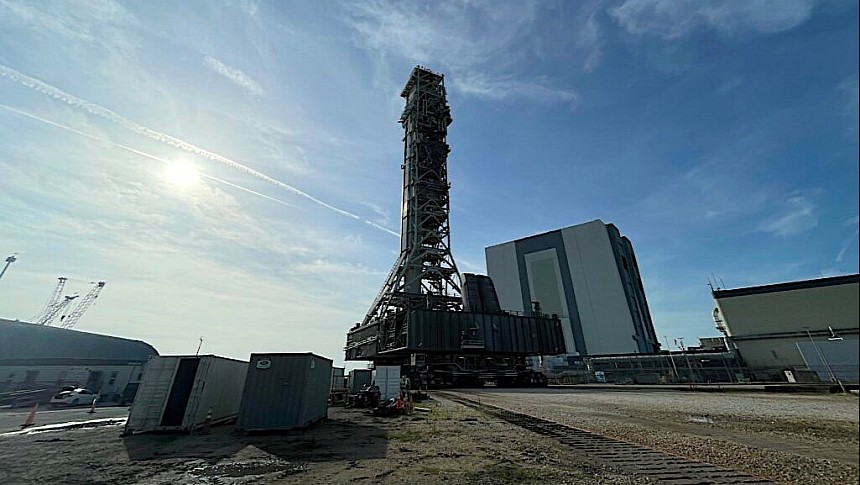If you really think about it, the fall of next year still is, well, more than a year away. For most of u, that's more than enough time to prepare for pretty much anything. For NASA engineers working on the Artemis II mission, a year probably seems anything but long enough.
It's in the fall of 2024 when the Artemis II mission is scheduled to launch, taking humans once more on a trip around the Moon. In space exploration such a long time is more like tomorrow, so the pace of preparations seems to be picking up at the facilities involved in the project.
At the beginning of the week for instance NASA announced it had completed acoustic tests of the Orion spaceship meant to take a crew of four humans to the farthest point from home in history.
Despite what the name would have you believe, acoustic tests are not, for instance, meant to check how much noise the ship and its occupants can take, or how much noise they make. Sure, sound is used, thrown at the Orion by means of large stacks of speakers, but as a means to generate vibrations that are similar to what the spacecraft will have to endure during launch and flight.
We're told the tests were completed successfully, but the data gathered is yet to be analyzed, so we have no idea what it meant for the spacecraft itself.
Separately NASA announced on Wednesday one of the supporting pieces of hardware for the mission, the mobile launcher, is on the move.
You may be familiar with this piece of equipment as it was largely responsible for the many delays and some of the launch scrubs during last year's Artemis I mission.
Towering 380 feet (116 feet) above the ground, the mobile launcher is where the SLS rocket and Orion spacecraft are assembled, but also from where they launch. Since assembly and launch take place from different locations, the launcher can move.
It is presently doing so, now traveling to the famous Launch Pad 39B. It doesn't carry the rocket with it, but it needs to reach the pad to allow NASA people to conduct tests and perform necessary upgrades. When they feel the time is right, the guys over at NASA will even conduct a launch day demonstration for the crew.
Speaking of crew, on deck for the Artemis II mission will be four people, including the first woman and person of color to be involved in a lunar mission.
The crew comprises Reid Wiseman, Victor Glover, Christina Hammock Koch, and Jeremy Hansen. They will not set foot on the Moon, but they will travel to a distance of 230,000 miles (370,000 km) away from our planet. That's 6,400 miles (10,300 km) beyond the satellite…
At the beginning of the week for instance NASA announced it had completed acoustic tests of the Orion spaceship meant to take a crew of four humans to the farthest point from home in history.
Despite what the name would have you believe, acoustic tests are not, for instance, meant to check how much noise the ship and its occupants can take, or how much noise they make. Sure, sound is used, thrown at the Orion by means of large stacks of speakers, but as a means to generate vibrations that are similar to what the spacecraft will have to endure during launch and flight.
We're told the tests were completed successfully, but the data gathered is yet to be analyzed, so we have no idea what it meant for the spacecraft itself.
Separately NASA announced on Wednesday one of the supporting pieces of hardware for the mission, the mobile launcher, is on the move.
You may be familiar with this piece of equipment as it was largely responsible for the many delays and some of the launch scrubs during last year's Artemis I mission.
Towering 380 feet (116 feet) above the ground, the mobile launcher is where the SLS rocket and Orion spacecraft are assembled, but also from where they launch. Since assembly and launch take place from different locations, the launcher can move.
It is presently doing so, now traveling to the famous Launch Pad 39B. It doesn't carry the rocket with it, but it needs to reach the pad to allow NASA people to conduct tests and perform necessary upgrades. When they feel the time is right, the guys over at NASA will even conduct a launch day demonstration for the crew.
Speaking of crew, on deck for the Artemis II mission will be four people, including the first woman and person of color to be involved in a lunar mission.
The crew comprises Reid Wiseman, Victor Glover, Christina Hammock Koch, and Jeremy Hansen. They will not set foot on the Moon, but they will travel to a distance of 230,000 miles (370,000 km) away from our planet. That's 6,400 miles (10,300 km) beyond the satellite…









